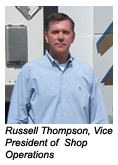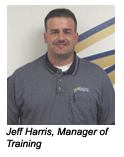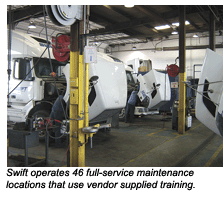A training program for technicians at Swift Transportation Co. is helping ensure quality service is provided to the fleet’s customers
“Our focus is on providing consistent availability of equipment for our customers,” states Russell Thompson, vice president of shop operations at Swift Transportation Co. Inc. “If our vehicles are in the shop they can’t haul freight, so reducing downtime is one of our main goals. We train our technicians to maintain and repair equipment correctly and in a timely manner, and that raises the level of quality in the service we provide to our customers.”

For the 1,335-person maintenance staff at Swift, including about 1,200 technicians, that effort is a full-time job. The carrier, headquartered in Phoenix, Ariz., operates the largest truckload fleet in the U.S. 18,000 tractors and 49,000 trailers are domiciled at 46 facilities.
Overseeing training programs for technicians at Swift is Jeff Harris, manager of training. “Our training department is charged with developing and administering programs for several levels of tractor and trailer technicians,” Harris relates. “In each of the training levels, technicians are provided with a comprehensive package, a list of skills, tasks and essential job functions that must be completed successfully before moving on to the next level. Supervised by a trainer, a shop supervisor or a certified person at each facility, technicians must demonstrate proficiency in each area and pass a written exam.”

Swift currently has five tractor technician training levels and two levels for trailer technicians. All entry level staff members learn about shop safety, maintenance department policies and procedures, repair order processing and shop equipment and practices. Second level “safety lane and PM technicians,” add a focus on inspections and minor repairs for specific vehicle systems and components. Third level “PM service technicians” cover more in – depth system and component areas and fourth and fifth level “maintenance technicians” represent the fleet’s most experienced staff members.
Incentives
The self-paced nature of the training program means some technicians at Swift complete two or three levels of training per year while others take longer. Technicians with previous experience are eligible for abbreviated versions of the tests. Significant pay increases accompany each level so there are incentives for technicians to advance.
Training materials at Swift are developed using a variety of sources, Harris reports, including information from manufacturers that is specific to the equipment the fleet is operating. “With 46 full service maintenance locations,” he says, “utilizing vendor supplied training is difficult to coordinate. As a result, our department has four regional trainers who attend vendor training programs and then bring the material presented to each shop in their regions and to every technician on every shift.”

Changes and additions to technician training at Swift are made as often as necessary. “One reason for a change, for instance, may be a new specification or a new technology,” Harris points out. “In those cases, training is implemented well before the new component or system arrives in the fleet vehicles so the staff is ready. Another impetus is maintenance cost analyses that can point to high cost areas where training may be beneficial. The latest wave, for example, covered electrical starting and charging systems.
Other research can also lead to ideas for new training at Swift. “We look at things like technician productivity compared to standard repair times,” Harris explains. “We also evaluate what we’re outsourcing to local dealers. For example, the multitude of new sensors on trucks was making it difficult for technicians to diagnose problems. In one shop, we were sending as many as eight trucks to a dealer each day, and if the dealer’s shop was busy it could take three days to get the vehicle back. A training program in diagnosing trouble codes was implemented and by the following week, trips to the dealer were virtually eliminated.
“Determining future training needs is also part of our ongoing efforts,” Harris continues. “One area of focus now, for example, are the 2007 engines that will be added to the fleet in the coming months. Other items include roll stability systems, and driver comfort items such as auxiliary power, heating and cooling units. In addition, 2010 engines are right around the corner and there are several initiatives related to idle control systems because it’s becoming extremely expensive to idle a truck. Staying up to date and bringing technicians up to speed before new items are introduced into the fleet is critical. Otherwise, you’re bound to have a problem.”
Remaining competitive
Swift’s comprehensive training programs are also helping recruit new staff and address technician shortages, Russell Thompson relates. “As we grow we have to add to our staff and at the same time we need to be competitive to attract and retain people,” he says. “One source of competition is dealerships, which tend to pay technicians more to cover their rates. The technician shortage is also an issue and varies from region to region depending on the strength of their economies.
“Our goal is to keep our annual turnover under 20 percent,” continues Thompson, “but in an operation this size that means bringing in over 200 new people per year. We are always look for experienced help in places like the military To attract entry level people, we work with technical schools, training programs and high schools. As an incentive, new technicians can lease a full set of tools from us, with no mark up in cost, and then they will own them once they are paid off.”
Swift has also implemented a change in practices in its shops that it feels will help create a more attractive work environment for technicians, and result in a more productive maintenance operation. “Studies indicated that in our shops, which can be very large, highly trained technicians were spending a considerable amount of time doing things like finding keys, getting paperwork and retrieving parts from inventory,” Thompson explains. “We now have “quick lanes,” and have those things delivered to them so work is not interrupted. In addition, shop management is focused on developing a driver-friendly environment to ensure that the truck is fixed right the first time, and that the driver is comfortable when engaging with shop employees.”
Those changes, Thompson notes, are a reflection of the realization at Swift that its technicians are a major part of efforts to reduce downtime and keep costs as low as possible. “It’s all about maintaining a high level of uptime and keeping trucks available,” he concludes. “ Changing practices to support technicians more effectively, and providing high quality ongoing training programs brings value to the company and our customers.”
